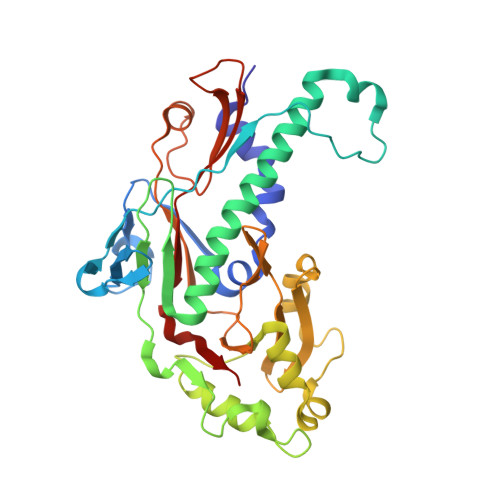Characterization of a Primordial Major Capsid-Scaffolding Protein Complex in Icosahedral Virus Shell Assembly.
Davis, C.R., Backos, D., Morais, M.C., Churchill, M.E.A., Catalano, C.E.(2022) J Mol Biology 434: 167719-167719
- PubMed: 35820453
- DOI: https://doi.org/10.1016/j.jmb.2022.167719
- Primary Citation of Related Structures:
7SJ5 - PubMed Abstract:
Capsid assembly pathways are strongly conserved in the complex dsDNA viruses, where major capsid proteins (MCP) self-assemble into icosahedral procapsid shells, chaperoned by a scaffolding protein. Without a scaffold, the capsid proteins aggregate and form aberrant structures. This, coupled with the rapid co-polymerization of MCP and scaffolding proteins, has thwarted characterization of the earliest steps in shell assembly. Here we interrogate the structure and biophysical properties of a soluble, assembly-deficient phage lambda major capsid protein, MCP(W308A). The mutant protein is folded, soluble to high concentrations and binds to the scaffolding protein in an apparent SP 2 :MCP(W308A) 1 stoichiometry but does not assemble beyond this initiating complex. The MCP(W308A) crystal structure was solved to 2.7 Å revealing the canonical HK97 fold in a "pre-assembly" conformation featuring the conserved N-arm and E-loops folded into the body of the protein. Structural, biophysical and computational analyses suggest that MCP(W308A) is thermodynamically trapped in this pre-assembly conformation precluding self-association interactions required for shell assembly. A model is described wherein dynamic interactions between MCP proteins play an essential role in high fidelity viral shell assembly. Scaffold-chaperoned MCP polymerization is a strongly conserved process in all the large dsDNA viruses and our results provide insight into this primordial complex in solution and have broad biological significance in our understanding of virus assembly mechanisms.
- Program in Structural Biology and Biochemistry, University of Colorado Anschutz Medical Campus, Aurora, CO, USA.
Organizational Affiliation:
















